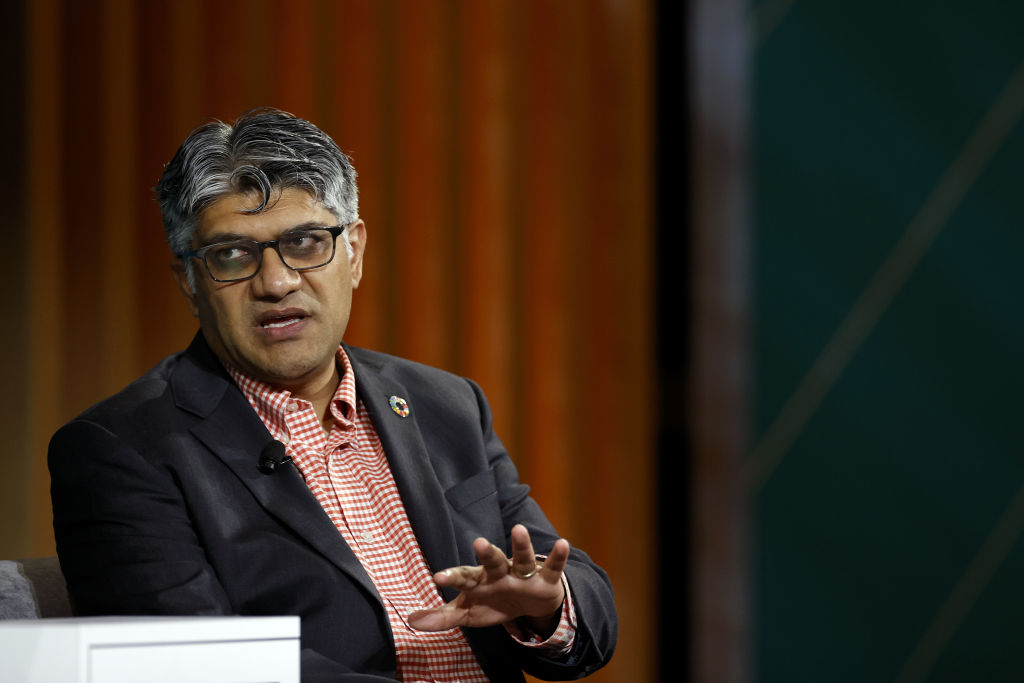
(To get this story in your inbox, subscribe to the TIME CO2 Leadership Report newsletter here.)
Figuring out how to finance the energy transition is a massive conundrum. The International Energy Agency says annual clean energy investment will need to hit $4 trillion by the end of the decade. Jigar Shah can provide a key piece of the puzzle—for the businesses that choose to work with him.
As the director of the U.S. Department of Energy’s Loan Programs Office (LPO), Shah has the ability to loan companies more than $400 billion collectively to help finance clean technology projects. He told me that he’s seen an uptick in interest from the private sector since he took the job in the early days of the Biden Administration, but nonetheless getting companies to commit remains harder than one might think. “I can’t name a single sector that’s been easy,” he says. “Every one of them is their own kind of impossible.”
Shah’s work is important in its own right. His office has the unique ability to single-handedly accelerate the energy transition, giving huge loans to key projects and companies that can help bring critical technologies to market. After the office was first funded in 2007, for example, it made a crucial loan to Tesla that helped the company become the superpower that it is today. But Shah’s work also offers a bigger lesson: succeeding in the energy transition will inevitably require businesses to challenge themselves to change ingrained practices.
More from TIME
“There’s a lot of people who just are like, can we do big things again?” says Shah. “And I hope to prove to people that we can do big things again.”
The LPO exists to address a very particular challenge. It doesn’t give venture capital money, where a large portion of projects would be expected to fail. Instead, it works more like a commercial bank that finances proven ideas that require a lot of capital to scale. The idea is that a loan from the LPO for a new technology will help convince commercial banks that they, too, can safely lend for such projects. For that reason, the Inflation Reduction Act significantly increased its ability to write loans to more than $400 billion from the $40 billion it had remaining at the beginning of the Biden presidency.
Read more: Why Investing in Climate Action During a Recession Is a Smart Business Move
But it’s easier said than done. I caught up with Shah on April 24, in New York City’s Penn Station of all places, as I arrived in the city and he was heading home from a clean energy finance conference. Shah has devoted significant time and resources to getting facetime with private sector leaders and convincing them to do business with his office. It helps that Shah is a trusted voice with a storied career in the private sector and a recognizable role co-hosting a well-known clean energy podcast, but the challenge has remained nonetheless.
“I wish it got easier and people were like, ‘oh, Jigar. I heard your podcast and I went on your website and filled out a loan application,” he told me. “Never! I’ve got to work with each one of them across the finish line, to put the resources into getting it done. Some of them I had to browbeat. But we’re getting them. Each one.”
Working with the LPO also requires businesses to think differently. Shah says that companies will often send their government relations staff to meet with his office—even though these officials don’t typically have the authority to make investment decisions. Just as challenging, many of the managers typically empowered to make big investment decisions resist exploring avenues to finance projects beyond the traditional lenders they’re accustomed to doing business with.
“They have been told over and over and over again that doing these kinds of big bold ideas is above your pay grade, don’t dream big,” says Shah. “And we’re finally telling them to dream big.”
Shah says the best way to convince companies to engage with the program is to show how it works by simply making loans. Last summer, for example, the LPO made a $504.4 million loan guarantee for the world’s largest hydrogen storage facility to be constructed in Utah. Using hydrogen to store energy—including clean energy—has been proven to work, but it has yet to achieve widespread adoption. The LPO loan guarantee can help show banks it’s worth financing these projects across the country.
“The only way to do this is by showing people loan by loan how this occurs,” says Shah. “How the public-private partnership was structured, and what role the city played, and what role the state energy financing institution played, what role the utility played—just kind of lay it out deal by deal.”
The obvious lesson for the private sector is that the LPO is open for business. The office has 141 active applications totaling $121.1 billion in value requested. That’s a large sum, but the office still has significant room to do more.
But there’s a bigger lesson for companies, too. In this new era of rapid energy and climate transition, we all benefit from thinking about how we might do things differently.
More Must-Reads From TIME
- The 100 Most Influential People of 2024
- The Revolution of Yulia Navalnaya
- 6 Compliments That Land Every Time
- What's the Deal With the Bitcoin Halving?
- If You're Dating Right Now , You're Brave: Column
- The AI That Could Heal a Divided Internet
- Fallout Is a Brilliant Model for the Future of Video Game Adaptations
- Want Weekly Recs on What to Watch, Read, and More? Sign Up for Worth Your Time
Write to Justin Worland at justin.worland@time.com